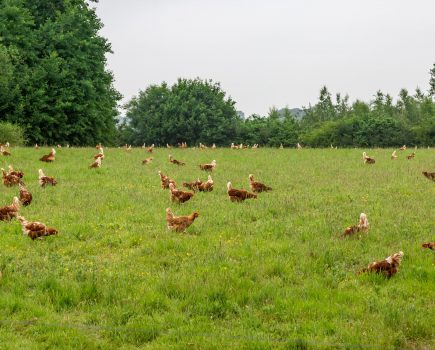January 10: The Soil Association has applauded the campaigning efforts of celebrity chefs Hugh Fearnley-Whittingstall and Jamie Oliver to improve the welfare standards of chicken production.
The Soil Association has applauded the campaigning efforts of celebrity chefs Hugh Fearnley-Whittingstall and Jamie Oliver to improve the welfare standards of chicken production. A general shift towards more ‘free range’ production would certainly be a positive step forward. But one still some way behind the Soil Association’s organic poultry systems, which ensure truly free range birds and offer the highest standards of animal welfare as acknowledged by respected animal welfare groups such as Compassion in World Farming. Intensively farmed chickens reared for meat can be housed in flocks 30 – 40,000 strong. Even the RSPCA’s Freedom Food standards allow 16,000 egg-laying birds per house, and there is no limit on flock size for free-range meat birds. In contrast, Soil Association organic standards recommend flock sizes of 500 – with absolute maximum flock sizes of 1,000 for meat birds and 2,000 for egg birds allowed only with special permission and additional management measures in place. All animals on Soil Association organic farms must have access to outdoor ranges and pasture, with an emphasis on enabling the animals to express their natural behaviour. Unlike intensively-reared birds, organic chickens can’t be given routine doses of antibiotics which weaken the animal’s natural immune system so increasing reliance on drugs, as well as being linked to creating antibiotic resistant ‘superbugs’ with serious human health implications. The minimum age organic chickens can go to slaughter is 81 days, compared to 56 days for free-range birds, and around 42 days for intensively reared chickens. Because of these more stringent welfare standards, the lower stocking densities and the near double life-times of organic chickens, it costs organic farmers more to raise them and this higher cost is reflected in prices paid by consumers. Robin Maynard, Soil Association Campaigns Director, said: “The industrial poultry lobby complain that the programmes don’t give viewers ‘a balanced argument’, yet no intensive producer appeared willing to allow the cameras into their units. Farmers should operate as if they had a webcam perched on their shoulder beaming everything they do on their farms into the nation’s sitting rooms. All types of farming have aspects that some people might be concerned about, yet better there be transparency and public debate than secrecy. When some farmers are ashamed to show what’s going on at their farms then that system clearly needs changing.” ‘Free-range’ production is a significant improvement on intensive, indoor systems but the reality of large-scale ‘free-range’ production can be very different to the image portrayed or that expected by consumers: A 2006 study concluded that ‘many of the birds in free-range poultry production systems do not leave the house’. Other studies have shown that the number of non-organic ‘free-range’ birds venturing outside can be as low as 12-15% of the flock at any one time. Apologists for intensive poultry production responding to the Channel 4 programme have claimed that, “The UK and the EU lead the world in animal welfare” and that “British poultry farming is a highly regulated sector”. The reality of intensive poultry standards – as demonstrated by Hugh Fearnley-Whittingstall and Jamie Oliver – suggests otherwise.







